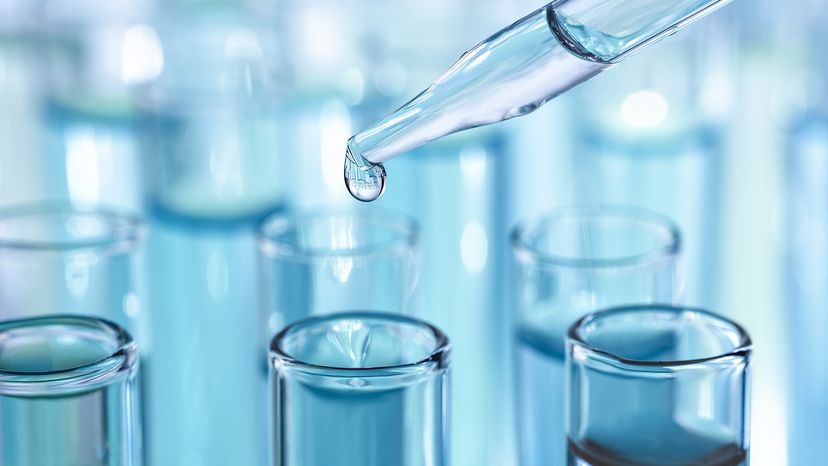There are seven acids that are universally recognized for their strength and reactivity, including:
- Chloric acid (HClO₃)
- Hydrobromic acid (HBr)
- Hydrochloric acid (HCl)
- Hydroiodic acid (HI)
- Nitric acid (HNO₃)
- Perchloric acid (HClO₄)
- Sulfuric acid (H₂SO₄)
Chloric Acid
Chloric acid (HClO₃) is a clear liquid and a potent member of the strong acids group, known for its powerful oxidizing properties. It's corrosive to metals and tissue. As a strong acid, it completely dissociates in water, releasing a high concentration of hydrogen ions (H+) and chlorate ions (ClO₃⁻).
This characteristic enables chloric acid to participate in a wide range of chemical reactions, particularly in the synthesis of explosives and dyes and as a reagent in laboratories.
Its robust oxidizing ability not only defines its significant role in industrial processes but also demands careful handling and storage to prevent reactive hazards.
Hydrobromic Acid
Hydrobromic acid is formed when hydrogen bromide gas is dissolved in water. This solution ranks among the most potent known mineral acids, due to its exceptional ability to completely dissociate into hydrogen ions (H+) and bromide ions (Br-) in an aqueous solution.
Its high reactivity and strength make hydrobromic acid an essential component in the chemical industry, particularly in the manufacture of various inorganic bromides, including those used in pharmaceuticals, photography and as catalysts in other chemical reactions.
Hydrochloric Acid
Hydrochloric acid (HCl) is a fundamental and widely used strong acid, known for its role in the digestive systems of humans and many other animals, as well as its extensive application across various industrial sectors.
Produced by dissolving hydrogen chloride gas in water, this potent acid exhibits complete dissociation in aqueous solutions, yielding a high concentration of hydrogen ions (H+) and chloride ions (Cl-).
This property makes hydrochloric acid an invaluable reagent in the production of chlorine, plastics and pharmaceuticals, as well as in metal processing and water treatment processes.
Hydroiodic Acid
Hydroiodic acid (also known as hydriodic acid) is an extremely acidic solution, composed of hydrogen iodide (HI) dissolved in water. It stands out as the second strongest acid of hydrogen and a halogen.
This acid is known for its comprehensive dissociation in aqueous solutions, where it releases a significant concentration of hydrogen ions (H+) and iodide ions (I-).
As a widely used chemical reagent, hydroiodic acid plays a crucial role in organic synthesis, including the production of iodine-containing compounds and in the reduction or cleavage of certain materials.
Its potency and utility make it a valuable asset in pharmaceutical manufacturing, research laboratories and various industrial processes.
Nitric Acid
Nitric acid (HNO₃) stands as a pivotal strong acid with profound impacts across a spectrum of scientific and industrial domains. Characterized by its ability to completely dissociate in water, it releases nitrogen oxides, hydrogen ions (H+) and nitrate ions (NO₃-) into the solution, exhibiting its strong acidic nature.
This acid is renowned for its role in the manufacture of fertilizers and explosives like nitroglycerin and trinitrotoluene (TNT) as well as in the production of plastics and dyes.
Its aggressive oxidizing properties, combined with its versatility, make nitric acid indispensable in both research and industrial settings.
Perchloric Acid
Perchloric acid (HClO₄) is one of the most powerful strong acids, surpassing even sulfuric acid in terms of its oxidative capabilities and acidic strength.
This makes perchloric acid a critical reagent in analytical chemistry, where it is utilized in precise volumetric analyses and the preparation of stable perchlorate salts.
Additionally, its use in the synthesis of rocket fuel and explosives underscores the compound's high reactivity and potential for energy release. The acid's ability to react with a wide array of organic and inorganic compounds without leaving behind residue makes it invaluable in the purification of metals and the manufacture of pharmaceuticals.
Given its potency, perchloric acid must be handled with extreme caution to avoid hazardous reactions.
Sulfuric Acid
Sulfuric acid (H₂SO₄) is one of the most widely used and produced chemicals worldwide, renowned for its central role in the industrial sector. As a strong acid, it exhibits complete dissociation in water, yielding a high concentration of hydrogen ions (H+) and sulfate ions (SO₄²⁻).
This acid's versatility is evident in its diverse applications, ranging from the manufacture of fertilizers and chemicals to the processing of petroleum and the production of detergents and plastics.
Sulfuric acid also plays a pivotal role in the production of batteries, particularly lead-acid batteries for vehicles. The acid's ability to act as a dehydrating agent and its use in refining metals and processing minerals further highlight its indispensability in numerous chemical synthesis and industrial processes.
However, given its corrosive nature, sulfuric acid must be handled with extreme care.
